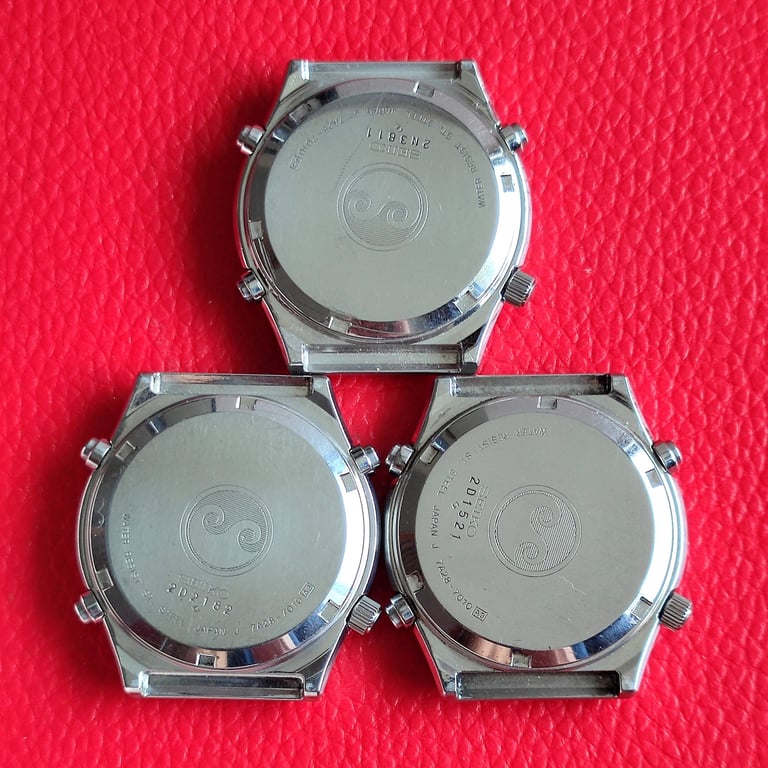Collector's Corner
A selection from our in-house collection of specially curated timepieces from the 1960s to the 1980s


The jumbo case, Breitling GMT is a rare and beautiful pilot's watch with distinctively colored inner bezel. Most have the two-tone beige and brown combination with a much smaller percentage sporting the incredible beige and blue combination. The dial features a colorful hands configuration with orange hands (hour, minute and chronograph) and a yellow GMT hand. The rotating, 24-hour inner bezel has a lighter (day) and a darker (night) hue. The GMT complication allows time displaying in two different time zones simultaneously.
The GMTs were made in 2 references the Chrono-matic ref. 2115, and much rare manual version ref. 812 powered by the venerable Valjoux 724 movement (based on the Valjoux 72). From discussion with Breitling experts, a limited number of cases for this version were all batch manufactured in 1968 and it is estimated that less than 100 were ever assembled / sold. At its heart is the famous GMT version of the Valjoux 72, with a different minute wheel and an extra hour wheel for the 24 hour hand.
Vintage Eye Watches is proud to be one of the biggest dealers of these jumbo cased GMTs. Both variations are a member of our permanent collection.
Breitling GMT ref 2115 & 812
This image represents likely the largest gathering of the very rare GMT ref 812 in the World!
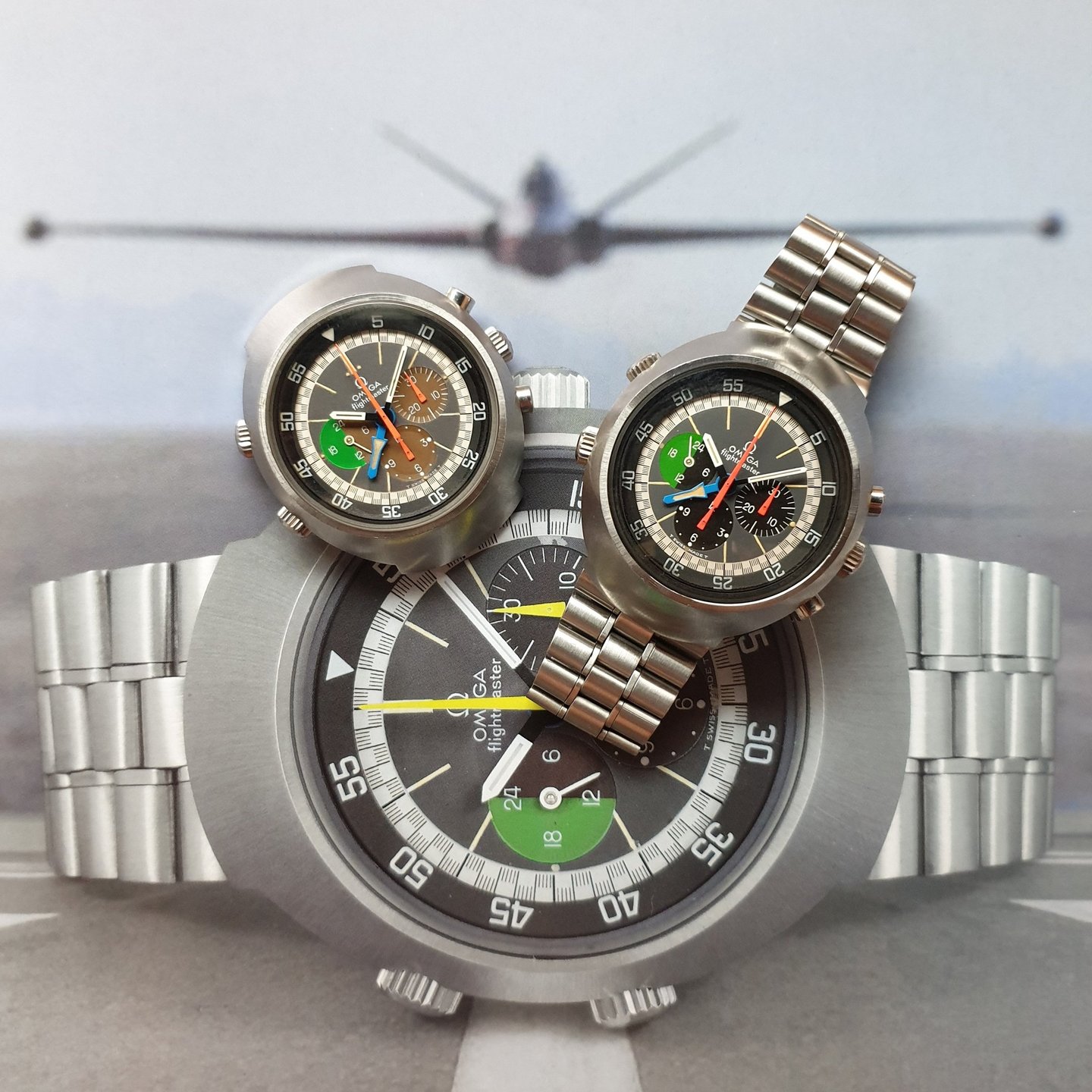

The Flightmaster ref. 145.013 was an incredibly ambitious project for Omega to undertake in 1969. Not only was it purpose-built as an answer to the burgeoning trans-continental airline industry, but it was built to standards well beyond most other pilot watches. It boasted the same water resistance as serious dive watches of the time!
In the same year that the Swiss industry giants were preoccupied with developing the first automatic chronograph, and the Speedmaster landed on the moon, Omega introduced a radically designed tool watch, with a highly distinctive over-sized case, 3 crowns, 2 pushers and 7 (!!) hands. Omega period literature referred to the Flightmaster as a ‘Pilot’s watch that has rather more than a revolving bezel,’ a statement which actually held the purpose of showing to the market the superiority of their model in relation to other popular GMT watches like the Rolex GMT or the Glycine Airman. In these the second hour hand was not independently adjusted, so in order for the operator to see the second time zone, he had to use the revolving bezel as well. The Flightmaster though, has a 12 Hour-GMT complication. The hand moves independently and is set through the auxiliary crown located at 10 o’clock on the case.
The Flightmaster was the first model which incorporated the colour-coded pushers. The auxiliary crowns on the left side of the case have a circular indentation in them and are colour-coded to their function… Blue for the second hour hand, black for the under-crystal bezel. In addition, the pushers on the right side of the watch also have indentations on them as well and have yellow/orange paint on them. These are colour-keyed to the sub-register hands that indicate chronograph elapsed time. Another fact that stressed the attention to detail that the Omega engineers dedicated to the watch was that special ‘professional’ versions were supplied with yellow cadmium coated hands which were extra legible when aircraft cockpits were lit with infra-red lights.
For serious Flightmaster collectors, we highly recommend the authoritative resource book, “FLIGHTMASTER ONLY” which details in amazing detail the story of the development of the watch as well as all of its functions and variations. For us at Vintage Eye Watches, our favourite is the first reference, 145.013 for two primary reasons: the back/green bicolor subdial (representing night & day) and the lower profile case. The production run for these was also much shorter. It is increasingly difficult to find mint examples to collect, many have issues with uneven fading, deterioration of the dial, and melting of rubber gasket around the outer turning bezel.
1969 Omega Flightmaster 145.013
The most revolutionary & innovative pilot's tool watch from the beginning of the Jet Age


The Breitling SuperOcean 2005 comes from a period when various watch brands set the trends for the coming decades with their full creativity and bold ideas. This diver's chronograph was first introduced in 1964 and featured a very unusual and creative design. While the classic chronograph featured a central chrono seconds hand and minute totalizer, the SuperOcean featured a single central minute hand. But how to signify the activity status of the chronograph if there is no second hand? That is done by the small round window at 6 o'clock. It is black in the initial state. If you start the chrono, the status display jumps to the second of its three positions and the large green dot is displayed. If you stop the chronograph, a small green dot appears. After resetting the chronograph, the black dot will return again. This intelligent functionality was accomplished through an in-house modification of the Valjoux 7731 caliber. The second generation (MK3) from the early 70's has a cool yachting bezel. A special look of this watch is created thanks to the large tritium markers and the square-tipped chrono minute hand.
The First Automatic SuperOcean & one of the first automatic chronograph dive watches ever built! 1969 marked the launch of the caliber Chrono-Matic, one of the first automatic chronograph calibers, developed in partnership with Heuer-Leonidas and Buren-Hamilton. This revolutionary caliber combines the performance and functionality of a chronograph with the comfort of an automatic watch, which doesn’t need to be wound every day. Breitling launched its first SuperOcean automatic (Ref. 2105) with the newly patented waterproof rotating bezel fitted on an extra-large 48mm case, water resistant to 20ATM. The striking, orange-colored design elements characteristic of the early 1970s and the lime-green luminous indices give the black/white dial a fantastic and refreshing vintage look which still looks modern today. The caliber of the Ref. 2105 is equipped with a 15-minute countdown timer at 3 o'clock with five minutes marked in orange and a 6-hour totalizer at 9 o'clock.
Breitling SuperOcean 1960's & 70s
"Slow Seconds" ref 2005 Mk1 & Mk3 and Chrono-matic ref 2105
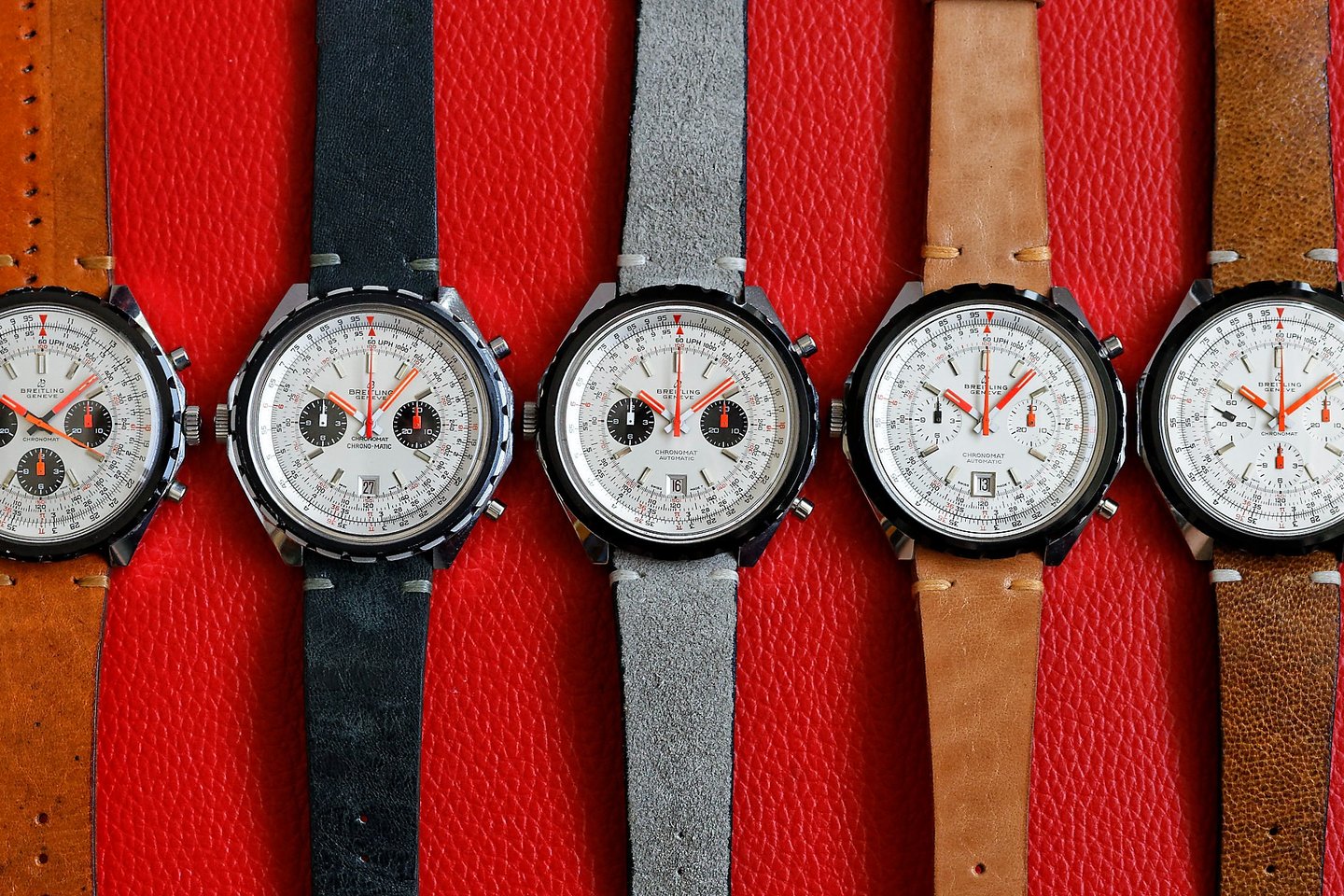

The Breitling Chronomat, with its now famous slide-rule scale, was released in 1941 and has been one of the longest running lines for the Swiss company ever since. The advent of the Chrono-Matic movement within the Chronomat happened during an interesting time in horological history, with companies around the world competing with one another to release the very first automatic chronograph movement.
This Breitling represents the perfect marriage between the iconic Chronomat and Navitimer design of the 1960s with the bolder architectural case design that became popular in the 1970s. The layered scales on the outer dial are a cool design element, but act as true instruments for calculation once you master their usage. This example features a bi-directional rotating bezel with a scale that moves with it. By using the rotating scale, the wearer can measure speed, distance travelled, and even solve mathematical problems.
Breitling assembled two versions of the reference 0818. One was powered by the Venus 178 manual wind chronograph movement (with 3 subdials), the other was powered by the famous automatic caliber 11 or 12 on (with 2 subdials and a date window). Dial-wise, the version with the reverse panda (predominantly black) was the most common. The rarer are the panda versions.
By far the rarest and most sought after, is the all-white dial, which we at Vintage Eye watches nickname as the “Albino” dial. This results in a truly eye-catching dial, the expanse of white only broken by the stylized fluorescent orange hands. These very rarely appear in the open market, and lately on quite faded, well-worn examples.
Breitling Chronomat ref 0818 “Albino”
The White ‘Unicorn’
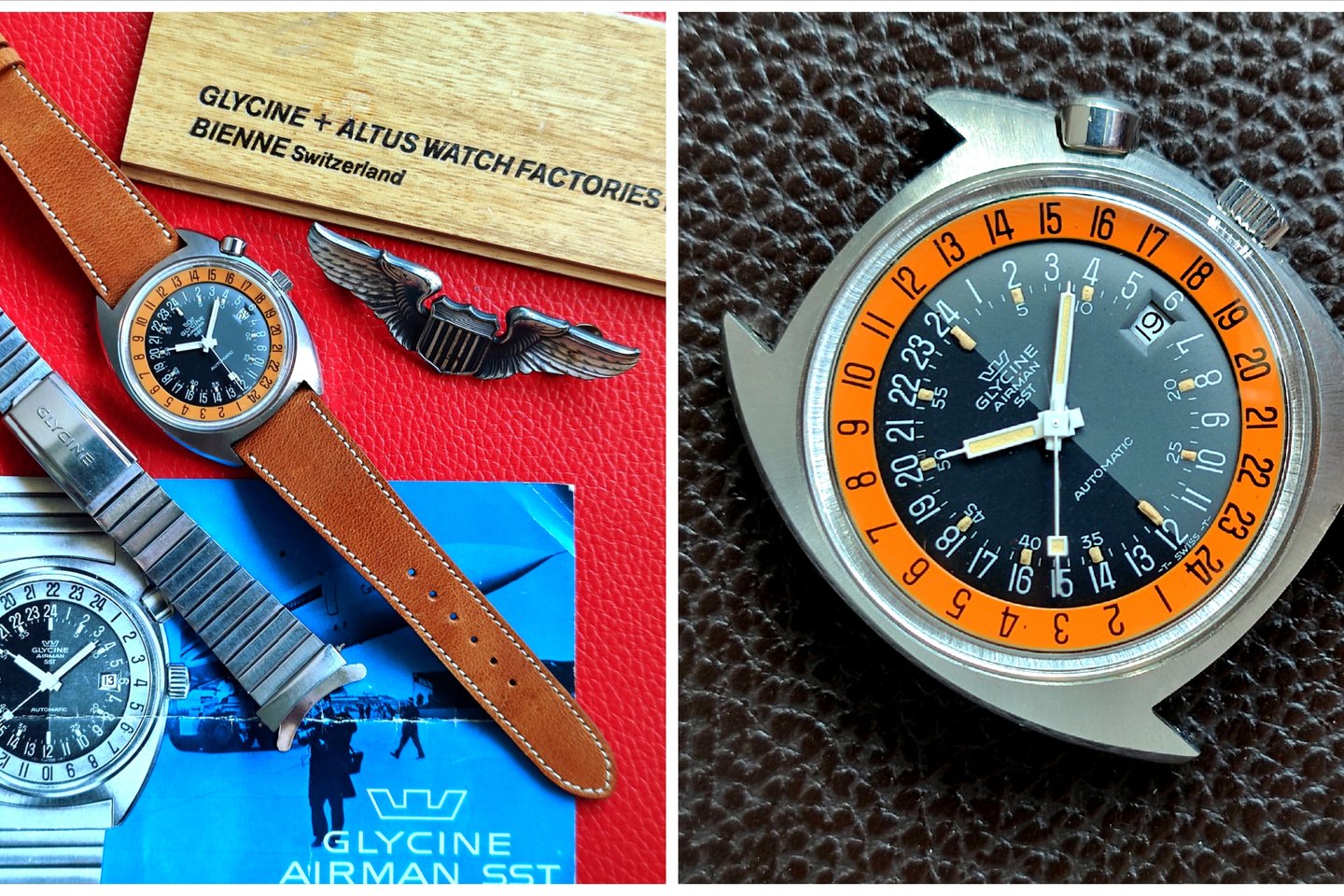

Few have missed the story of Cinderella returning home too late and turning into a pumpkin, alas, the 1967 Glycine SST creation became one for a very different reason. It’s glorious orange 24 hour turning inner chapter, left collectors with few other naming options. The magnificent and striking top case with matte polished lines could be described as Tourneau, ‘C’ or UFO shaped depending on who one met or when one started collecting. The presence of the watch with its oversized case, pumpkin orange insert, and striking matte two tone black and grey split AM/PM dial was symbolic of the bold designs appearing in the late 60’s and early 70’s. It is distinctly different to the design heritage of its 1953 popular GMT history making predecessor.
Please read the full article at: https://flightbirds.net/the-stroke-of-midnight-the-glycine-pumpkin-sst/
The Stroke of Midnight ... the Glycine Airman SST
Our special, one owner watch, featured on Flightbirds.net
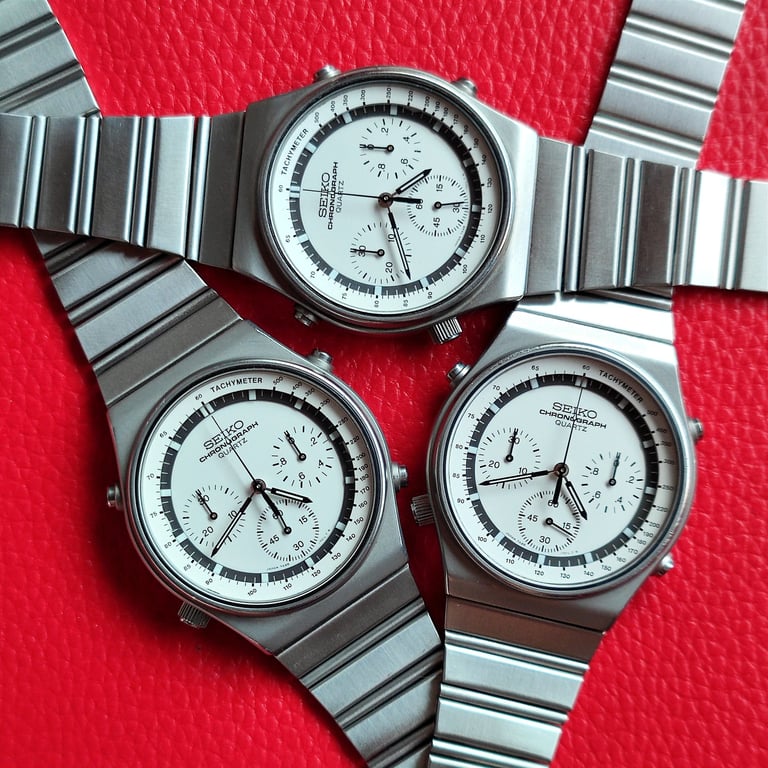

Outside of the astronomically-priced original Seiko Astrons, Beta 21s, and other very early and collectible examples, the vintage market for quartz watches has remained relatively untouched by the recent wave of interest from watch collectors. While the argument for quartz vs mechanical watches will undoubtedly continue ad infinitum, we hope to make the case that there are vintage quartz watches that are worth collecting, even if they aren’t quite as rare. And to kick things off, let's start with perhaps a particularly eye-catching model: the Seiko 7A28-7010.
Please read the full article at: https://twobrokewatchsnobs.com/seiko-7a28-vintage-quartz-watches/
The Seiko 7A28-7010: A Case for Collecting Vintage Quartz Watches
Visit our "Seiko" Store to see our selection of carefully curated, collectible Quartz models
